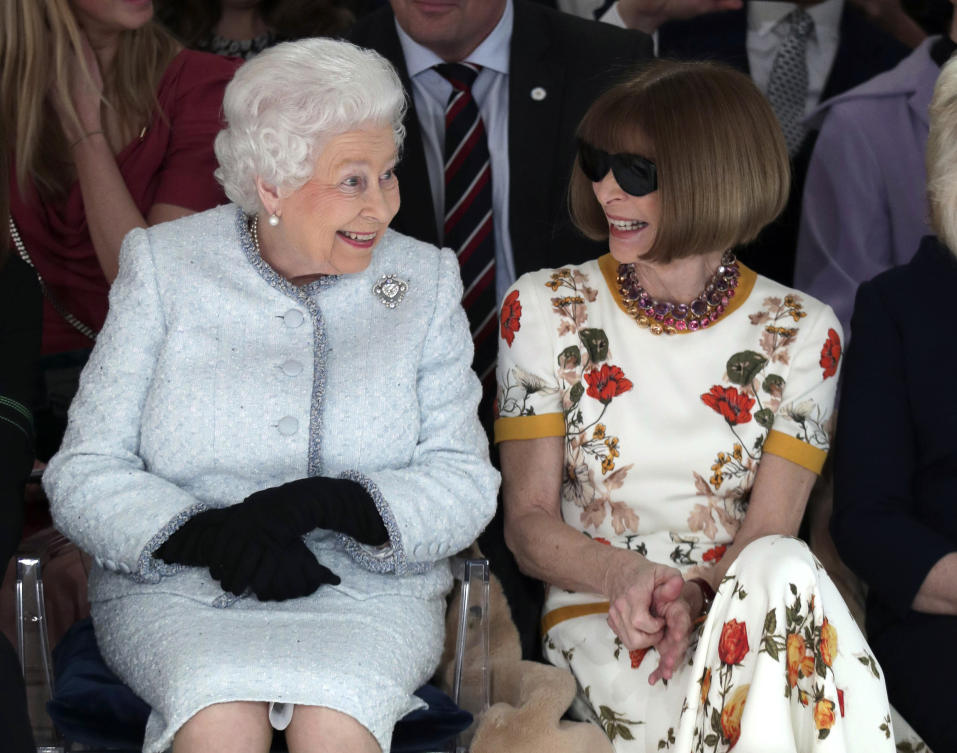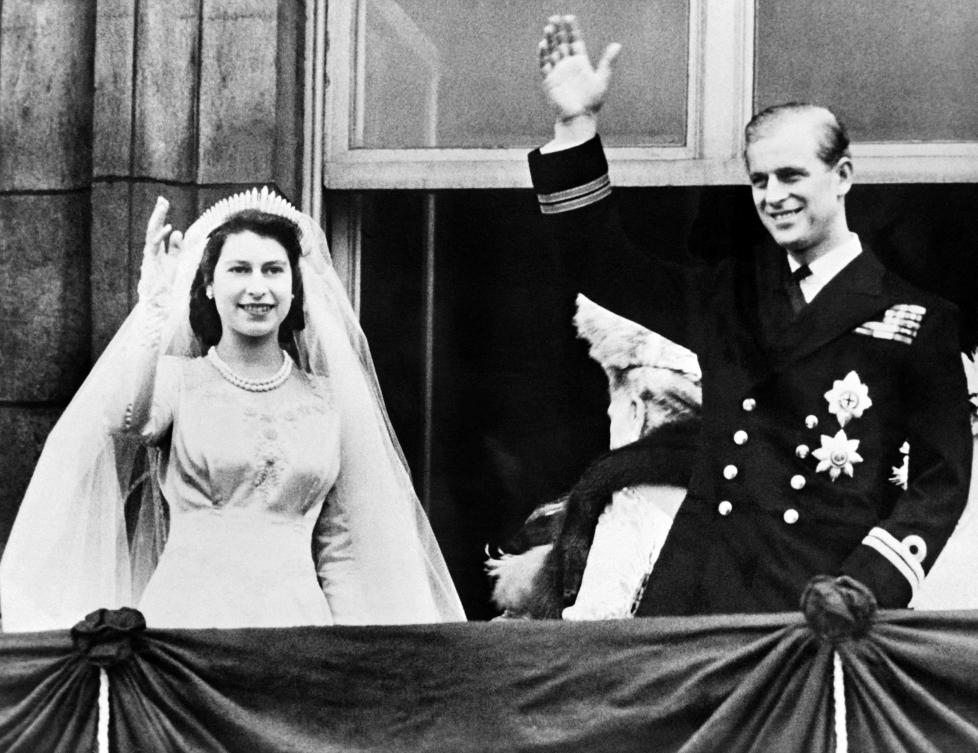NEW YORK: Queen Elizabeth II just might have the hardest working wardrobe on the planet.
“Every outfit worn in public is carefully calibrated to inspire or remind, to signal gratitude or respect, to convey a sense of power or familiarity,” wrote The Mail on Sunday in 2015. “Her Majesty neither sets trends nor follows them — but while she is deaf to the siren call of fashion, she has her own singular style.”
From her tiaras, hats and Hermes scarves to her Launer London handbags and even her umbrellas, the queen’s style has been hyper-documented since her birth, young princess days, ascension to the throne and now, more than 70 years into her reign, as she celebrates her Platinum Jubilee at age 96.

Britain’s Queen Elizabeth sits next to Vogue fashion editor Anna Wintour as they view Richard Quinn’s runway show before presenting him with the inaugural Queen Elizabeth II Award for British Design in 2018. (AP)
Now known for her bright coats (so as to be seen by huge crowds) with matching brimmed hats, the queen was a young, glamorous princess and monarch in earlier decades.
Some highlights of the queen’s style through the years:
Her childhood
Cotton or wool? The queen’s very birth prompted style debate, writes Bethan Holt, fashion editor of The Telegraph and author of this year’s “The Queen: 70 Years of Majestic Style.”
Her wardrobe from the get-go was a topic of national fascination with a layette sewn by her mother and grandmother, and a little help from underprivileged women throughout Britain. Declaring that babies in wool looked like “little gnomes,” Lilibet’s mum, then the Duchess of York, opted for frilly cotton, rejecting anything too fussy.
When sister Margaret came along four years later, the princesses often twinned it, dressing alike into their teens. But the future queen as a girl “never cared a fig” about clothes, according to her former governess, Marion Crawford.
“She wore what she was told without argument, apart from a long, drab mackintosh that she loathed,” Crawford wrote in her controversial memoir, “The Little Princesses.”
The young heiress
With the tumultuous abdication of her uncle and the rise of her father to become King George VI, Princess Elizabeth became heiress presumptive (absent any future male heir, who never materialized).
Enter couturier Norman Hartnell, according to Holt. While there were other designers, he was entrusted with dressing the family as they emerged on the world stage, including the two princesses at ages 11 and 6. Their “bow-adorned dresses and little cloaks signalled a return to the calm dependability of the monarchy,” Holt wrote.
During World War II, 18-year-old Elizabeth began to make more public appearances, training as a mechanic in early 1945 toward the end of the war. It was the only time she routinely wore trousers (and boiler suits), according to Holt.
The queen was, and remains, a practical dresser when necessary, but also glamorous in sparkly gowns when the moment beckoned. And she often went short sleeved or with no sleeves at all, something that doesn’t happen today. She stood for photos with Prince Philip in a simple, light-colored dress with sleeves above the elbow and peekaboo low heels on her size 4 (6 US) feet shortly before their wedding in 1947.
“People want to see their royals looking like royals, but equally, they don’t want to think that taxpayers’ money is being blown away,” said Nick Bullen, editor in chief of True Royalty TV.
The wedding dress
Hartnell transformed the florals of Botticelli’s “Primavera” into a gown of white crystals and pearls. But it wasn’t easy. There were diplomatic questions in the still-miserable aftermath of the war, Holt wrote. Customs impounded 10,000 seed pearls from the US, and journalists were assured that the origins of the silk produced in Kent and woven in Essex were worms from “nationalist” China rather than “enemy” Japan.
Thousands in the UK sent in their ration coupons for Princess Elizabeth to use for dress materials. That would have been illegal, so she saved up her own and asked the government for 200 extra, Holt told The Associated Press.
“It showed the thirst there was in the country for this big moment of glamor,” she said. “In recent years, we have known the queen and Prince Philip as this sweet old couple but we have to remember, in that time they were this dazzling, glamorous new couple on the scene.”

In this file photo taken on November 20, 1947 Queen Elizabeth II and Prince Philip, Duke of Edinburgh wave at their wedding, on November 20, 1947, in London. (AFP)
The wedding was not without behind-the-scenes drama. Queen Mary’s Fringe tiara, made by Elizabeth’s grandmother from a necklace given to Mary by Queen Victoria, snapped right before the ceremony and was rushed off to crown jeweler Garrard for repair.
The dress, and the wedding, offered “a real moment of hope,” Holt said.
Her hemlines
She settled years ago on skirts and dresses just below the knee, but her hemlines were sometimes an issue for senior members of her family. In 1952, the 25-year-old queen led her family in mourning at her father’s funeral in accordance to strict dress codes set out during the reign of Queen Victoria, according to Holt.
As Queen Mary curtsied to her granddaughter and kissed each cheek, she admonished: “Lilibet, your skirts are much too short for mourning,” Holt writes. The new queen’s dress hovered well above her ankles yet respectfully below the knee, while that of her grandmother reached the ground. All, including Queen Elizabeth II, were shrouded in black veils, as Queen Victoria was for 40 years after the death of Prince Albert in 1861.
“The evolution of the queen’s style from young princess to longest-serving monarch in British history has her being of the time but not following fashion,” Bullen said.
Finding a uniform
The queen we know today wears sensible block heels or brogues, usually handmade by Anello & Davide, a custom Launer perched on her arm and a brooch on one shoulder. She goes with kilts and skirts in tartans and plaids as her country style. But the queen of the early 1950s charmed the world in nipped-in waists, pencil silhouettes and some floaty, full experiments as a post-war fashion quake took hold in the country.
“In the early years of her reign, she really embraced Dior’s New Look aesthetic, and women looked to her outfits as a source of inspiration, much like people do with the Duchess of Cambridge today,” said Kristin Contino, style reporter for Page Six.
There was a playful glamor in the 1970s, ‘80s and ‘90s, including a bold multicolored evening dress in 1999 for a Royal Variety Performance. Created by Karl-Ludwig Rehse, it featured a riotous sequin diamond-pattern bodice of bright yellow, blue, green and pink.
There were also some trouser days and a turban phase in the ‘60s and ‘70s amid a wide range of hat styles.
The queen learned of her father’s passing on a stop in Kenya en route to Australia. Some reports indicate she was wearing jeans for an encounter with a herd of elephants the moment her father died in his sleep at Sandringham, Holt wrote. She donned slacks on safari in Zambia in 1979, and a trouser set in 2003 as she left King Edward VIII hospital in London after a knee operation.
It was Margaret, the rebel, who was renowned as a fashion plate in Dior and other designers, and her influence on Elizabeth was tangible. Little sister helped the queen scout new British designers and introduced her to up-and-comers, such as milliner Simone Mirman, according to Holt. Mirman created some of the queen’s standout hats, including her Tudor-style “medieval helmet,” as Hartnell called it, in soft yellow, for the 1969 investiture of Prince Charles.
“Margaret was really in tune with fashion. She would have been the one reading Vogue. And so she would often go with the queen to appointments to help her inject that little bit of extra style into her looks,” Holt said.
Usually sticking to British designers, the queen has a long-held fondness for silk scarves by the French fashion house Hermes. The brand has issued several special designs in her honor. It did so in 2016 with a horse-themed scarf to mark her 90th birthday.
One doesn’t equate the queen of today with a mad rush to copy her style, but for a brief spell in the 1950s women could do just that thanks to her love of cotton dresses in dainty floral or abstract prints from Horrockses Fashions, a British ready-to-wear brand, Holt said.
Another look from those early years stands out as well. In October 1952, soon after ascending the throne, the queen was a sensation at the Empire Theatre for a royal viewing of the musical comedy “Because You’re Mine.” She wore a tuxedo-like Hartnell gown in black with a white front and wide lapels in a halter design, paired with long white gloves, a tiara on her head and a diamond bracelet on one wrist.
She hit every magazine and newspaper the next day. Manufacturers rushed to copy it. It was dubbed the Magpie and she never wore it again.
Matchy matchy
The queen loves to color coordinate, sticking to bright colors and pastels in coats and floral dresses today.
That goes for her signature clear, bird-cage umbrellas as well. They’re made by Fulton Umbrellas and are attainable at $30 or less, though the queen’s are custom made. She owns about 100 in a rainbow of colors but contrary to reports, she doesn’t possess 200 of her favorite Launer bags, Holt said. Gerald Bodmer, who rescued Launer in 1981 after a period of decline, was keen to clear up that myth.
“He says she has several styles in several colors. He says that 200 is very far off the mark,” Holt said.
Launer extends the straps of her leather bags to make it easier for her to hang them on her arm, and they make them lighter for her to carry. And what does she carry? Bullen said he’s heard there’s always a lipstick, a handkerchief and a photo of Prince Philip, who died last year at 99.
Irish designer Paul Costelloe, who dressed Princess Diana in the 1980s and ‘90s, told the AP of the queen’s style: “She’s a bit like a schoolteacher, a good schoolteacher. She never shocks. She gets it right.”




























